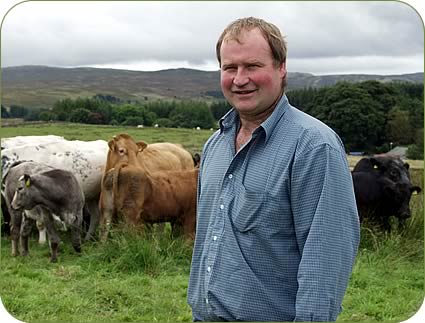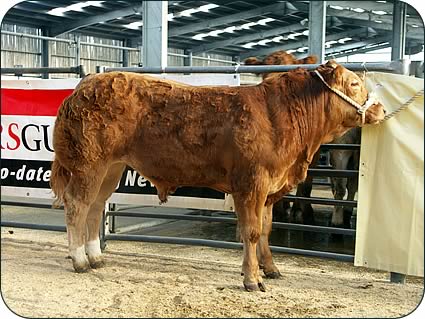Jennifer MacKenzie is an agricultural photo journalist with almost 30 year's experience. Operating from her base in Cumbria, Jennifer undertakes mainly industry-related freelance writing and photography.
Bright Future for Blondes
The Blonde has a bright future according to Mike Harrison whose suckler
herd which produces Blonde crossbred calves has picked up a national award.
The suckler herd run by Mike on the Cumbrian upland unit Sleddale Hall,
Shap, which produces calves sired by a pedigree Blonde bull, has won the
British Blonde society’s biannual UK commercial herd of the year
award.
Mike and his parents Henry and Joyce have stayed faithful to the Blonde
for the last two decades, breeding both pedigree and commercial cattle.
And the breed which is easily managed and produces quality suckled calves,
suits the system on the traditional 1,000 acre Less Favoured Area unit,
where input costs are closely monitored and labour is kept to a minimum.
 |
| Mike Harrison |
Sleddale Hall is tenanted from United Utilities which owns the neighbouring
Wet Sleddale reservoir. There are rights on Ralfland Common and the Harrisons
also own 165 acres.
Stocking numbers to meet the requirements of the Lake District Environmentally
Sensitive Area scheme are 1,100 mostly Swaledale and Texel cross ewes and
150 beef cows.
The cows are predominantly three quarter beef bred Belgian Blue cross Limousin
and Simmental with the majority of replacements being bought-in.
Cow numbers include the 12-cow pedigree Shapfell Blonde herd which was
founded 20 years ago after the Harrisons had used a Blonde bull commercially
and were impressed with the calves.
Mike Harrison said: “The Blonde bull produces good conformation calves
and now that the export market has re-opened they are in big demand because
they are long and lean. I think there is a lot of potential there.
“I believe the Blonde has a good future in today’s UK beef
production system.
“The cross-bred cows are easily calved to the Blonde and we have
very few assisted calvings, even of heifers and they have a quiet temperament.
Then cows and calves thrive on rough grazing which runs from 980ft to 1,450ft
above sea level at Sleddale Hall.”
As Mike runs the farm with only help from his father and a man at lambing
time, the cows must be easily managed.
To produce an income throughout the year, the cows are calved in three
batches – 40 in September and October, 70 in May and 40 in February
and March.
The award’s previous winner Bill Thompson, of Fraserburgh, who judged
the competition, said: “Mike Harrison’s herd was the obvious
winner. His calves are consistently good for both bulls and heifers, particularly
considering the type of hard farm he is rearing them on.”
Current senior stock bulls are Forthview Rosco, bought in Perth for 1,700gns
in Perth 2002 and Easterton Pedlar bought privately from Scottish breeder
John Owen.
Two five year old Shapfell bulls are also being used as well as the November
2003-born Quicks USA bred by Andrew Quick of Crediton, Devon, which sold
for the then breed record price in Carlisle in May 2005 of 8,200gns.
A share has been retained in the home-bred bull Shapfell Bongo which was
sold privately to Cumbrian pedigree breeder Andrew Stott. The 19 month
old bull is sired by Whistley Dollar and goes back to a home-bred cow on
the female line. Semen has also been taken from the bull.
 |
| The bullock from Sleddale Hall which
was reserve overall champion at the Carlisle suckled calf show in October 2007 |
The success of the commercial cattle at Sleddale Hall is testament to
the Blonde and Mike sells bulls mostly at home to both commercial and pedigree
buyers.
The herd’s top price is 8,000gns for the bull Shapfell Mastermind
sold at Carlisle.
Most calves are sold at around 11 months old. Some heifers are retained
as replacements but those sold are in demand as replacements for upland
suckler herds.
They are sold through Penrith, Wigton and Carlisle markets and in 2007
the 135 calves sold averaged £642.
At the Carlisle autumn show and sale a heifer made £1,000 and Mike’s
reserve overall champion, a bullock, made £900. Both were bought
by cattle showman Willie Timms.
The Harrisons have picked up numerous tickets for their suckled calves
over the years, some of which have gone on to be primestock show winners.
Another regular buyer is Alan Barnett, of Brins, Shap who sold a bullock
in January 2008 at Wigton for 149p per kg, topping the market, and his
finished cattle are now in demand for export.
Most of the commercial replacements are bought-in as either bulling heifers
or as heifers with calves at foot to generate a quicker return.
 |
| Line-up of Sleddale Hall show calves entered for the October 2007 show |
Sleddale Hall is a hard farm and winters are long and wet. All the cattle
are housed from mid October usually to the end of April either in cubicles
or on slats with the calves having access to a straw-bedded area.
The cows are fed ad-lib silage and depending on their size, the calves
are creep fed a bought in concentrate, starting at 1.5kg a head a day and
increasing to 4kg maximum.
Cows and May-born calves are grazed on the farm’s highest rough pasture
which runs alongside the fell throughout July and returning in September.

